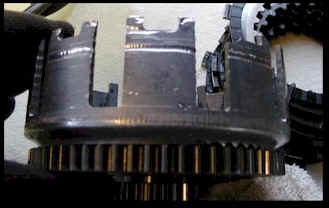Helpful Hints When Servicing Your KDX's Top End
This article is intended to be a supplement to your shop manual rather than a step by step guide to servicing your KDX's top end.
KIPS Valve Governor Shaft -1995 to 2002 KDX200/220.
The KIPS valve governor shaft is easily robust enough to withstand the demands place on it in normal operation yet you often hear of cases where a shaft has snapped and in some cases caused serious damage. Why is that? There are three reasons why it breaks and all are very easily avoided if you know what to watch for. You can find a picture of the shaft here, its part number 13234A and 13236 in the diagram.
1- It's very important to remember that the nut that fastens the gear to top the KIPS shaft uses a LEFT-HAND THREAD. To remove it you need to rotate the nut in the opposite direction than you're accustom to. Its not uncommon for people to either forget this or not be aware of this in the first place and end up tightening the nut rather than loosening it. In doing so you can apply an excessive amount of pressure on the KIPS shaft causing it to fatigue and break.
2 - The nut on top the KIPS shaft only requires 8.3N-m or 74 in-lbs of torque, that's not much. Buy or borrow an appropriate torque wrench and be sure the nut is properly torque. The KIPS shaft can be damaged if its over torqued, especially if its not supported.
3 - The MOST IMPORTANT thing to remember is that you must support the KIPS shaft while removing and installing the nut so the shaft doesn't twist . Most people will grasp the shaft just below the gear with a pair of pliers. I find that Robo Grip pliers or a small set of locking pliers work well.

So how do you know if the shaft has been damaged? Ideally you'd remove the shaft and inspect it. The shaft is normally deformed/fatigued or snapped near the bottom of the shaft where it connects to the centrifugal actuator.
If you or the previous owner weren't aware of the proper disassembly/reassembly procedure and the shaft did break the bottom section of the shaft is often falls into the clutch area and can wedge between the clutch basket and clutch cover. It can also wedge in the kick starter or gear shift mechanism preventing you from kick starting the bike or changing gears. If you've had problems with any of these take the time to insure a broken KIPS shaft isn't the culprit. If you are concerned your KIPS shaft may be damaged replacement shafts are available at a reasonable price from your Kawasaki dealer or Fredette Racing Products. Expect to pay less than $20.
Here's some idea of what typical damage might look like:

Thanks to Kyle Mortensen for the photo.
This article is intended to be a supplement to your shop manual rather than a step by step guide to servicing your KDX's top end.
KIPS Valve Governor Shaft -1995 to 2002 KDX200/220.
The KIPS valve governor shaft is easily robust enough to withstand the demands place on it in normal operation yet you often hear of cases where a shaft has snapped and in some cases caused serious damage. Why is that? There are three reasons why it breaks and all are very easily avoided if you know what to watch for. You can find a picture of the shaft here, its part number 13234A and 13236 in the diagram.
1- It's very important to remember that the nut that fastens the gear to top the KIPS shaft uses a LEFT-HAND THREAD. To remove it you need to rotate the nut in the opposite direction than you're accustom to. Its not uncommon for people to either forget this or not be aware of this in the first place and end up tightening the nut rather than loosening it. In doing so you can apply an excessive amount of pressure on the KIPS shaft causing it to fatigue and break.
2 - The nut on top the KIPS shaft only requires 8.3N-m or 74 in-lbs of torque, that's not much. Buy or borrow an appropriate torque wrench and be sure the nut is properly torque. The KIPS shaft can be damaged if its over torqued, especially if its not supported.
3 - The MOST IMPORTANT thing to remember is that you must support the KIPS shaft while removing and installing the nut so the shaft doesn't twist . Most people will grasp the shaft just below the gear with a pair of pliers. I find that Robo Grip pliers or a small set of locking pliers work well.

So how do you know if the shaft has been damaged? Ideally you'd remove the shaft and inspect it. The shaft is normally deformed/fatigued or snapped near the bottom of the shaft where it connects to the centrifugal actuator.
If you or the previous owner weren't aware of the proper disassembly/reassembly procedure and the shaft did break the bottom section of the shaft is often falls into the clutch area and can wedge between the clutch basket and clutch cover. It can also wedge in the kick starter or gear shift mechanism preventing you from kick starting the bike or changing gears. If you've had problems with any of these take the time to insure a broken KIPS shaft isn't the culprit. If you are concerned your KIPS shaft may be damaged replacement shafts are available at a reasonable price from your Kawasaki dealer or Fredette Racing Products. Expect to pay less than $20.
Here's some idea of what typical damage might look like:

Thanks to Kyle Mortensen for the photo.